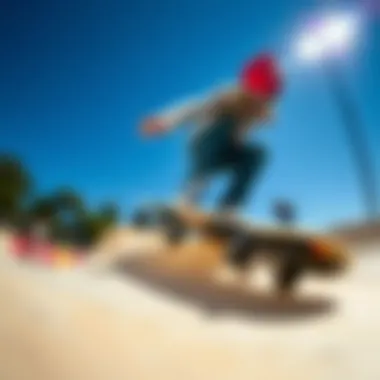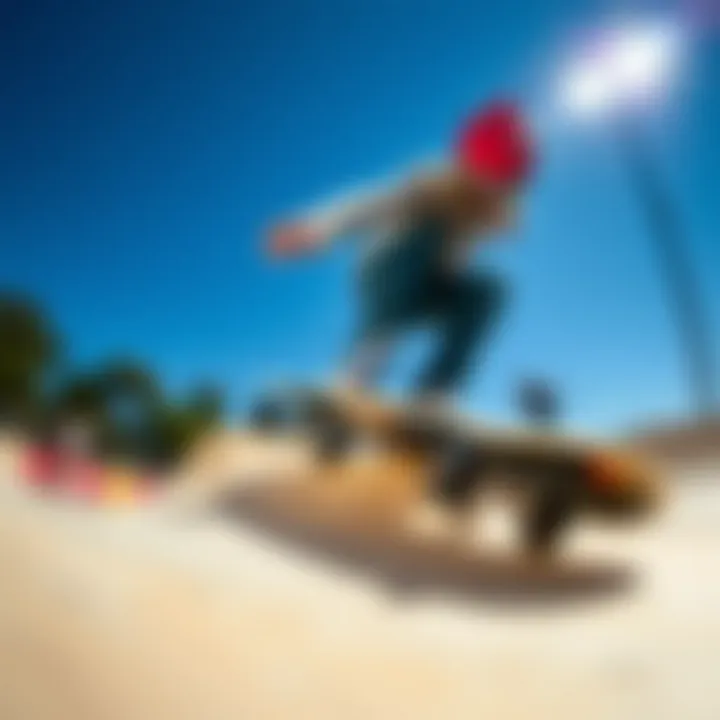Exploring the Craft and Culture of Fingerboarding


Intro
Fingerboarding, often seen as a miniature extension of traditional skateboarding, holds a unique place within the broader skate culture. It's not just a hobby for many; it’s a vessel of creativity and self-expression. From its early days, fingerboarding has evolved, adopting influences from street skating to vert antics, yet it maintains its distinct identity.
In this article, we will explore the various aspects of fingerboarding. We will highlight the essential techniques and tricks, delve into the gear required, and examine the cultural impact this niche has on the skateboard community. Whether you’re a seasoned pro or curious about picking up this engaging activity, there’s plenty to dissect. Among trick boards and handmade ramps, each element tells a story—let’s glide deeper into this captivating world.
Techniques and Tricks
Fingerboarding is more than just flicking a tiny board around; it involves mastering a range of skills, much like its full-sized counterpart.
Basic Tricks for Beginners
For those just starting, the foundational tricks set the stage for more advanced maneuvers down the line. Key basic tricks include:
- Ollie: The basic jump for any skateboarder, this trick is essential for gaining air.
- Kickflip: By using your finger to flick the board, it spins mid-air, providing a visual flair.
- Heelflip: Similar to the kickflip but involves a heel flick. It’s all about the technique!
- Grind: Utilizing edges of obstacles to perform a grind is a classic move in both skating and fingerboarding.
Mastering these fundamental tricks opens doors to more elaborate skills. Start with steady fingers and practice consistently—you'll quickly find your rhythm.
Advanced Techniques for Pro Skaters
As you gain confidence and skill, you may feel the itch to learn more complex tricks. Advanced techniques provide a fresh challenge:
- Fingerflip 360: An impressive aerial rotation that requires precise timing.
- Hardflip: A combination of a kickflip and an ollie, this trick showcases both flair and complexity.
- Smith Grind: An advanced grind maneuver that involves balancing on one truck while the other hangs off the ledge.
These advanced tricks require not just skill but creativity, as they allow fingerboarders to express their individual style and personality through their movements.
Gear and Equipment
To truly appreciate fingerboarding, one must consider the tools of the trade. The right gear not only enhances performance but also builds identity within the culture.
Essential Skateboarding Gear
Quality gear can make a significant difference. Commonly needed items include:
- Fingerboard: A mini board is crucial! Brands like Tech Deck and Initials have made names for themselves in this space.
- Ramps and Obstacles: Items like rail grinds or skate parks can enhance the practice session.
- Grip Tape: Just like regular skateboards, grip tape ensures fingers have traction.
- Trucks and Wheels: Lightweight yet durable components improve maneuverability and performance.
Latest Trends in Skate Gear
The fingerboarding scene is constantly adapting, with fresh designs and technology emerging. Popular trends currently include:
- Custom Boards: Enthusiasts are designing bespoke boards with unique graphics or materials.
- Scale Models: Realistic replicas of famous skate spots have become popular among collectors and skaters alike.
- Digital Platforms: Online communities on sites like Reddit encourage exchange of tips, tricks, and even achievements—a space to connect and grow within this community.
In the world of fingerboarding, every trick lands differently, just like every rider's style is one-of-a-kind.
As we dig into the next sections, we will further explore the cultural undercurrents and community aspects of fingerboarding while integrating the collective experiences that define this suburban art form.
Foreword to Fingerboarding
Fingerboarding is not merely a whimsical pastime; it is a fascinating intersection of skill, creativity, and culture that resonates widely within skateboarding communities. This section of the article serves as a crucial starting point, preparing readers to engage deeply with what fingerboarding entails. Through understanding the foundation and historical significance, enthusiasts and newcomers can better appreciate the artistic nuances and technical aspects of this miniature skateboarding practice.
Definition and Overview
At its core, fingerboarding involves using fingers to replicate skateboarding movements on a small skateboard replica, usually about 96mm long, which is designed especially for this purpose. While it may seem trivial at a glance, fingerboarding can serve as a vibrant form of expression—a canvas upon which enthusiasts can showcase their unique styles and techniques.


Fingerboarding can mimic the tricks of full-sized skateboarding: ollies, grinds, flips, and more, all executed with precision using mere digits. Beyond just physical play, it offers therapeutic benefits as it aids in the development of fine motor skills and hand-eye coordination. Indeed, for many, fingerboarding becomes a blend of sport, art, and friend circle, helping deepen the engagement with broader skate culture.
Historical Background
The roots of fingerboarding trace back to the 1970s when skateboarding surged in popularity. It began as a solution for skaters needing to practice tricks during inclement weather or when access to skate parks was limited. Early models were often homemade, crafted from scrap materials and improvised designs. These rudimentary boards gradually evolved, influenced by advancements in skateboard technology and the ever-expanding skate culture.
By the 1990s, as skateboarding gained mainstream recognition, so too did fingerboarding. Companies like Tech Deck began manufacturing complete fingerboards, catering specifically to this niche group of enthusiasts. The combination of collectibility and skillful tricks drew more people into the fold, transforming fingerboarding into a recognized subculture within the skateboarding scene. Today, fingerboarding boasts its own competitions, online communities, and even original gear, reflecting its rich and evolving ecosystem.
In summary, the art of fingerboarding is intertwined with a cultural history that speaks to adaptation and creativity. Those who invest time in this craft not only celebrate the essence of skateboarding but also keep an artistic spirit alive through their miniature performances.
Understanding the Techniques
Fingerboarding is more than just a pastime; it’s an intricate art that merges creativity with physics. Knowledge of various techniques not only enhances skill but also deepens appreciation for this unique form of skateboarding. By mastering techniques, enthusiasts can replicate tricks they admire and express their individuality through customized maneuvers. The significance of understanding these techniques lies in fostering growth, developing consistency, and sparking creativity among fingerboarders of all levels.
Basic Tricks for Beginners
For those just dipping their toes into fingerboarding, starting with foundational tricks can be incredibly rewarding. Basic tricks such as the ollie, grind, and shove-it serve as building blocks for more complex maneuvers.
- Ollie: This is the cornerstone of fingerboarding. Essentially, it involves popping the tail of the board down while dragging the finger up the deck to gain height. Mastery of the ollie opens the door to many other tricks.
- Grind: Positioning the board on a ledge or rail while utilizing the trucks to slide along is classic skateboarding territory brought down to the fingerboard level.
- Shove-It: By using the fingers to push the board underneath one’s hand, the board rotates 180 degrees while remaining in the air.
These tricks not only build a solid foundation but also instill confidence in fingerboarders. Practicing these will help beginners feel more comfortable when transitioning to intermediate techniques.
Intermediate Techniques
Once the basics are in the bag, fingerboarders often look to intermediate tricks to elevate their game. Here, the challenge ramps up, requiring more dexterity and control.
- Kickflip: This popular trick involves a swift motion with the fingers, adding a spin to the ollie. The key lies in timing - getting the right flick for that extra flip.
- Heelflip: Similar to a kickflip, but executed with a flick of the heel, giving it a distinct flavor.
- Smith Grind: A trick that requires a good amount of balance, where one truck grinds while the back truck hangs off the side.
Stepping up to intermediate techniques can feel a bit daunting, yet it often reignites passion among fingerboarders. Engaging in these tricks allows for greater exploration of the nuances of board control.
Advanced Fingerboarding Tricks
At this level, fingerboarders experience the thrill of true expression through their skillset. Advanced tricks can wow spectators and fellow enthusiasts alike, but they need practice and a deep understanding of mechanics.
- Noseblunt Slide: Balancing on the front truck while sliding is not for the faint of heart. It takes practice, precision, and nimble fingers.
- Bigspin: A combination of a shove-it and a 360-degree body rotation that comes off slick once perfected.
- Rail Flip: An impressive combination move where the board does a flip while grinding the rail, showcasing agility and timing.
Learning advanced techniques can not only showcase a fingerboarder’s talent but also contributes to a deeper sense of belonging within the skate culture community.
"Mastering fingerboarding techniques is like piecing together a puzzle; every new trick adds to the bigger picture of your skill set".
As fingerboarding techniques progress from simple to complex, they create pathways for self-discovery and creativity within each individual's journey, continually pushing the boundaries of what’s possible on a fingerboard.
Essential Gear and Equipment
Understanding the right gear for fingerboarding is crucial for enthusiasts at every level. Just like a musician wouldn't play an instrument that's out of tune, fingerboarders need quality equipment to perform their best. Being equipped with the right fingerboard can enhance tricks, improve stability, and ultimately raise the enjoyment level of the activity. Let’s break down what you need to know about selecting the right gear to maximize your fingerboarding experience.
Choosing the Right Fingerboard
When it comes to fingerboards, the choice can be overwhelming. With different brands, sizes, and designs flooding the market, how does one choose the perfect one? It’s not merely about aesthetics; the material and design can greatly influence your performance. For starters, look for fingerboards that feel comfortable in your fingers. Testing out different brands can help you find one that fits just right in the hand.
Pay attention to the width and length of the board as well; both aspects affect how you perform tricks. A wider board provides more surface area for your fingers, crucial for beginners who are starting to learn slides and grabs. On the flip side, a narrow board is often preferred by advanced skaters seeking more agility and responsiveness.
Components of a Fingerboard


Understanding each component of a fingerboard can enhance your experience and lead to better control and trick execution.
Deck Material
The deck’s material is a fundamental aspect of the fingerboarding experience. Most fingerboard decks are made from either wood or plastic.
- Key Characteristic: Wood decks, often made from maple or birch, offer a satisfying flex and grip that’s hard to beat. Their durability and feel closely mimic that of full-sized skateboards. Many skaters prefer this material for its stability and its ability to handle various tricks without warping.
- Unique Feature: The grain of wood provides aesthetic variations plus distinct patterns. This visual appeal often attracts hobbyists who enjoy collecting different designs.
- Advantages/Disadvantages: Wood is typically more durable than plastic but can be pricier. Beginners may find plastic options more affordable, yet they may lack the ‘feel’ specific to wood decks.
Wheels and Trucks
Wheels and trucks are what give fingerboards their movement, resembling the full-sized skateboard dynamics.
- Key Characteristic: Quality wheels are essential for achieving smooth rolls and flips. Most wheels are made of urethane, a material valued for its grip and shock absorption. The size of wheels can vary too; smaller wheels allow for faster rotations while larger ones provide better stability.
- Unique Feature: Trucks, which connect the wheels to the deck, come in different widths. This feature allows skaters to customize their setup according to their style. Wide trucks can offer more stability, while narrower ones might enhance trick responsiveness.
- Advantages/Disadvantages: Investing in good wheels and trucks can greatly affect performance. However, skaters must ensure compatibility between their board and components as mismatched sizes can affect ride quality.
Grip Tape
Grip tape might seem like a small detail, but it holds significant importance in fingerboarding.
- Key Characteristic: It provides traction for your fingers, preventing slips during tricks. The texture and adhesive strength can vary, and finding a tape that fits well with your board is essential.
- Unique Feature: Some grip tapes come with unique designs or colors, adding a personal touch to your fingerboard. You could choose a classic black, or something flashy to make your board stand out.
- Advantages/Disadvantages: While good grip tape enhances performance, a poorly chosen tape can hinder tricks or wear out quickly. Regularly checking and replacing worn-out grip tape is crucial for maintaining control.
Upgrading Your Gear
As one becomes adept at fingerboarding, the desire for better equipment often arises. Upgrading gear can lead to improved performance and exploration of new tricks. Consider swapping out to a higher quality deck, as this often brings enhanced feel and durability. Likewise, experimenting with different wheels and trucks can help in customizing your riding experience. Finding components that complement each other not only sharpens your skills but also reflects personal style—a blend of practical performance and creative expression.
In the expansive world of fingerboarding, the right gear becomes the foundation upon which skills are built. Whether you’re navigating the landing of a tricky kickflip or grinding on a miniature rail, having the proper equipment is indispensable for a fulfilling fingerboarding journey.
Cultural Significance
Fingerboarding transcends mere play; it acts as a cultural bridge among skateboarders, enthusiasts, and newcomers alike. This distinct form of art communicates not only skills and creativity but also fosters community connection. In an age where digital distractions are rampant, fingerboarding presents a tactile, engaging alternative that cultivates dexterity and precision. Its cultural significance lies in various domains—social, educational, and creative.
Fingerboarding in Skate Culture
Fingerboarding is deeply intertwined with the larger skate culture. It serves as a microcosm of the skateboarding world. The aesthetics of fingerboards often mirror their full-size counterparts, showcasing the same deck designs, grip tapes, and elaborate tricks. Just as skateboarding thrives around self-expression, so does fingerboarding allow individuals to exhibit their creativity through design and custom setups.
Moreover, fingerboarding provides a way for enthusiasts to connect with skate culture when physical skateboarding isn’t feasible. Be it during a rainy day or confined spaces like classrooms, fingerboarding keeps the spirit of skating alive. It embodies the 'street culture' ethos, showcasing gritty, raw creativity that’s often seen in real skate parks.
Communities and Competitions
Fingerboarding has developed its own communities and networks, creating spaces for enthusiasts to gather—both online and offline. Forums on platforms like Reddit and Facebook teem with discussions about techniques, gear recommendations, and the latest tricks. This online presence cultivates a global village where hobbyists can share their passion, discuss trends, and post videos to showcase their skills.
Competitions have also sprung up, reflecting the sport’s growth. Events held in local skate shops or organized through social media add a layer of excitement and camaraderie. They often attract a diverse crowd, bridging gaps between age groups and skill levels. There's a palpable energy when competitors face off, pushing each other to nail difficult tricks and innovate their styles.
Influence on Young Skaters
The impact on young skaters is profound. For many, fingerboarding serves as an introduction to the skateboarding world itself. A child picking up a fingerboard is not merely playing; they are learning balance, focus, and trick diversity. These skills translate well to the larger skateboarding scene, where physical practice on a full board is often the next step.
Fingerboarding teaches patience, encouraging youngsters to persist even when a trick doesn't land perfectly from the get-go. The immediate gratification of nailing a flip can inspire a lifelong love for skating. Moreover, as they interact with peers who share this interest, youngsters build social skills and form friendships that often transcend the fingerboarding world.
By becoming part of this enriching culture, young skaters cultivate a sense of belonging and connect to a community rich with history and tradition. As the passion for flicking their tiny boards develops, so does their appreciation for the art and craft of skating in all its forms.
"Fingerboarding is not just a hobby; it’s a doorway into the expansive world of skating and creativity. It holds the power to bring people together in ways that are both simple and profound."
Through its unique cultural lens, fingerboarding offers more than just a pastime; it is a journey into a vibrant world that thrives on collaboration, creativity, and community spirit. Embracing this art form can deeply enrich the skateboarding experience for individuals and communities alike.


Online Resources and Tutorials
The digital age has revolutionized the way we engage with hobbies, and fingerboarding is no exception. Online resources and tutorials play a crucial role in shaping the skills of both new and seasoned aficionados. With a multitude of platforms offering insights and learning opportunities, fingerboarders have access to a wealth of information that can significantly boost their skills and understanding of the sport.
One of the primary benefits of these resources is the immediacy of learning. Gone are the days when you had to rely solely on a few books or magazines. Now, you can find videos, articles, and even interactive sessions that cater to all skill levels. Whether you're a fresh starter or someone looking to perfect a trick, the internet has made it easier than ever to find specific techniques and methodologies.
Additionally, online tutorials offer various perspectives. Each fingerboarder has their unique style, and watching multiple tutorials can expose you to diverse methods that can influence your own practice. The ability to replay instructions at your own pace allows for a deeper understanding of the nuances that make up advanced tricks.
Video Tutorials and Channels
Video content is a powerhouse resource for aspiring fingerboarders. Platforms like YouTube host countless channels dedicated to fingerboarding. Creators such as Fingerboarder.com and Boardz offer step-by-step guides tailored for different skill levels.
These videos often showcase:
- Breakdowns of Tricks: Detail-oriented descriptions help beginners master movements fundamentally.
- Equipment Reviews: Insights into the best gear can help enthusiasts make informed purchasing decisions.
- Creative Sessions: Filmmakers share their unique styles, inspiring viewers to experiment within their own crafting.
You can interact with other viewers in the comment section. This community engagement can provide additional tips and humor as you navigate the learning process. Some creators even host live-streamed sessions, offering real-time feedback and personal guidance.
Online Communities and Forums
The importance of community cannot be overstated. Online forums and communities, such as those found on Reddit and various Facebook groups, provide platforms where fingerboarders converge. Here, enthusiasts share their experiences, challenges, and triumphs in an informal setting.
- Knowledge Sharing: Members regularly post questions on specific tricks, gear choices, and techniques. This culture of sharing enhances skills collectively.
- Supportive Feedback: If you post a video of your practice, chances are someone will offer constructive criticism, helping you hone your technique.
- Event Announcements: Many forums often share news on local or international competitions, so you'll never miss an opportunity to participate or spectate.
Future of Fingerboarding
The future of fingerboarding holds promise as it continues to evolve and adapt, much like traditional skateboarding. As we step into an era of digital integration and innovative approaches, the influence of technology and emerging trends becomes increasingly crucial. In this section, we will explore several aspects that shape the trajectory of fingerboarding, delving into not only its growth within subcultures but also its potential in mainstream contexts.
Emerging Trends
Fingerboarding is making strides beyond its niche beginnings. Various trends are surfacing that reflect a shift in both style and community engagement. One such trend is the emergence of custom fingerboards. Instead of just settling for mass-produced options, many enthusiasts are now opting for personalized setups. Here are some trends that are catching fire:
- Custom Decks: Enthusiasts take to platforms like Etsy or Instagram to find artisan creators who craft unique designs.
- Sustainable Materials: With rising awareness around environmental issues, more brands are beginning to focus on eco-friendly materials, like bamboo and recycled plastics, drawing attention from eco-conscious riders.
- Collaborations with Artists: Fingerboarding brands partner with artists to release limited edition decks and accessories, presenting high-end options for collectors.
These trends indicate that fingerboarding is not merely surviving; it's thriving, drawing in newcomers, who may find the allure of skate culture through this miniature lens.
Technological Advancements
As fingerboarding progresses, technology is reshaping the way enthusiasts interact with the art form. One significant change is the way tutorials are distributed. Platforms like YouTube and TikTok offer a wealth of video tutorials, enabling fingerboarders of all levels to learn and share their tricks easily. Beyond that, 3D printing technology is revolutionizing the manufacturing of fingerboards and parts.
- 3D Customization: Enthusiasts can design their components tailored to personal preferences, allowing for an unprecedented level of creativity.
- Augmented Reality (AR): Soon, we might see AR technologies enabling users to visualize tricks in virtual environments, improving their technique without the need for physical ramps or obstacles.
- Online Competitions: Due to recent global events, virtual competitions have become popular, removing geographical barriers and allowing a wider audience to engage in fingerboarding.
"With the incorporation of modern technology into fingerboarding, we are on the cusp of a renaissance in how we understand and practice this art."
The inclusion of these technological advances suggests that fingerboarding is not just a hobby; it may develop into a lifestyle, resonating with those seeking a balance of creativity, community, and skill-building.
Culmination
The realm of fingerboarding is not merely a pastime. It stands as a testament to the creativity and dexterity that enthusiasts bring forth in their miniature skateboarding adventures. In this article, we have journeyed through various aspects of fingerboarding, from its intricate techniques to its cultural implications within the broader skateboard community.
The Enduring Appeal of Fingerboarding
Fingerboarding captivates individuals for a multitude of reasons. For many, it’s the sheer joy of mastering a new trick or completing a challenging run. The simplicity of using one’s fingers as the vehicle for this sport makes it incredibly accessible; you don’t need a skateboard park or wide-open streets. Here are a few key factors contributing to its lasting appeal:
- Creativity at Your Fingertips: Each session offers the chance to express oneself, whether it’s through trick combinations or the design of the fingerboard itself.
- Community Connection: Online forums, local meet-ups, and competitions unite people in a shared passion. This camaraderie enhances the experience remarkably.
- Technological Integration: As we've discussed, digital platforms like YouTube and specialized websites provide resources that further develop skills and share knowledge. This integration not only fosters learning but also keeps the sport relevant to new generations.
For all these reasons, the allure of fingerboarding persists, drawing in newcomers while keeping seasoned veterans engaged. In the future, as trends continue to evolve and technology advances, fingerboarding may well see an even broader recognition.
"Fingerboarding is more than just a hobby; it's a community, a creative outlet, and a bridge between generations of skaters."

